The art of growing and caring for a bonsai tree is both a fascinating and deeply rewarding hobby. As an avid gardener and bonsai enthusiast, I’m thrilled to share the beauty and intricacies of cultivating these miniature marvels.
Bonsai is not just about gardening; it’s a form of living art that invites patience, creativity, and a deep connection with nature.
Whether you’re a seasoned bonsai artist or a curious beginner, the journey of nurturing these tiny trees is sure to bring a unique sense of fulfillment and joy.
Benefits of Growing a Bonsai Tree
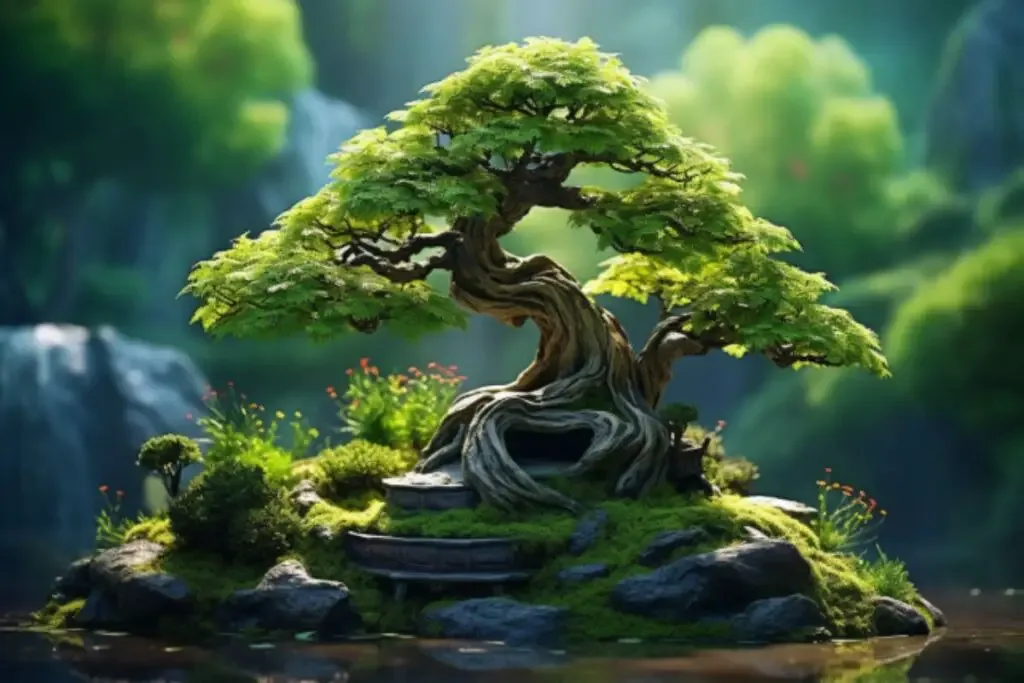
1. Mindful Relaxation
One of the most profound benefits of cultivating a bonsai tree is the sense of calm and mindfulness it brings. The careful pruning, shaping, and nurturing of a bonsai can be a meditative and stress-relieving experience, providing a peaceful escape from the hustle and bustle of daily life.
2. Artistic Expression
Bonsai cultivation is a beautiful blend of art and horticulture. Each tree is a living sculpture, and shaping it allows for personal artistic expression. It’s a way to channel creativity and develop an eye for aesthetics, balance, and harmony.
3. Connection with Nature
In our increasingly digital and urban lives, bonsais offer a valuable connection to the natural world. They bring the essence of ancient forests and natural landscapes into our homes and workplaces, fostering a deeper appreciation for the beauty and intricacy of nature.
My Favorite Bonsai Varieties
Delving into the world of bonsai, each variety tells its own unique story. From the elegant Japanese Maple to the sturdy Juniper and the adaptable Ficus, these are my top picks that captivate and inspire.
Join me in exploring the distinct charm and character of these enchanting bonsai varieties.
1. Japanese Maple (Acer palmatum)
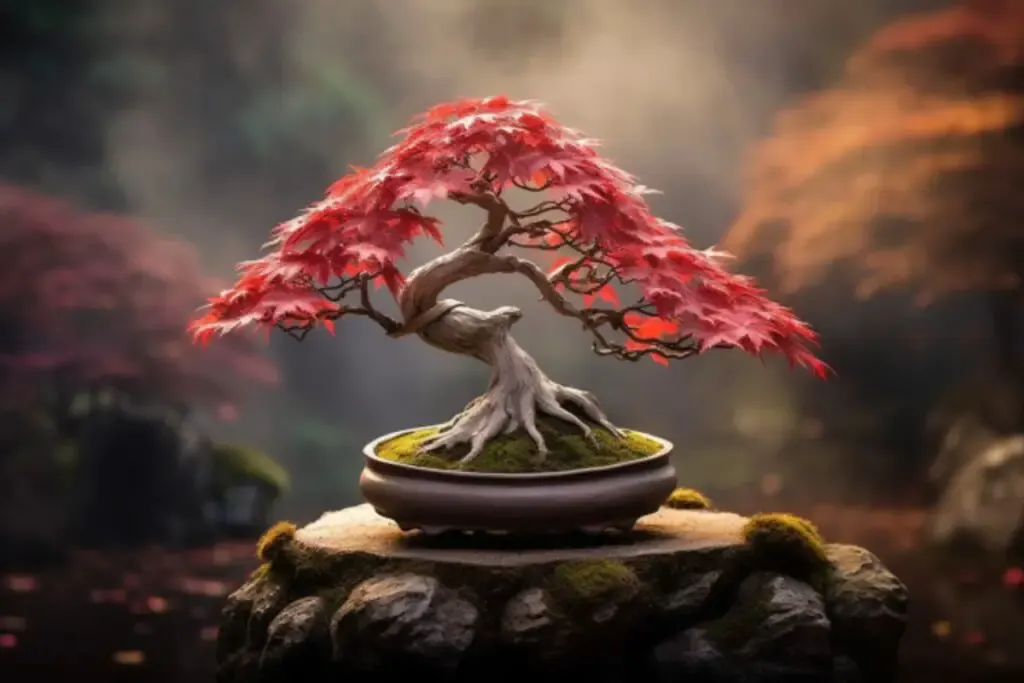
There’s something truly magical about the Japanese Maple. This bonsai favorite dazzles with its elegant leaf shapes and a spectacular show of colors in the fall. Watching it shift through the seasons is like witnessing a year-round dance of nature in miniature.
2. Juniper (Juniperus)
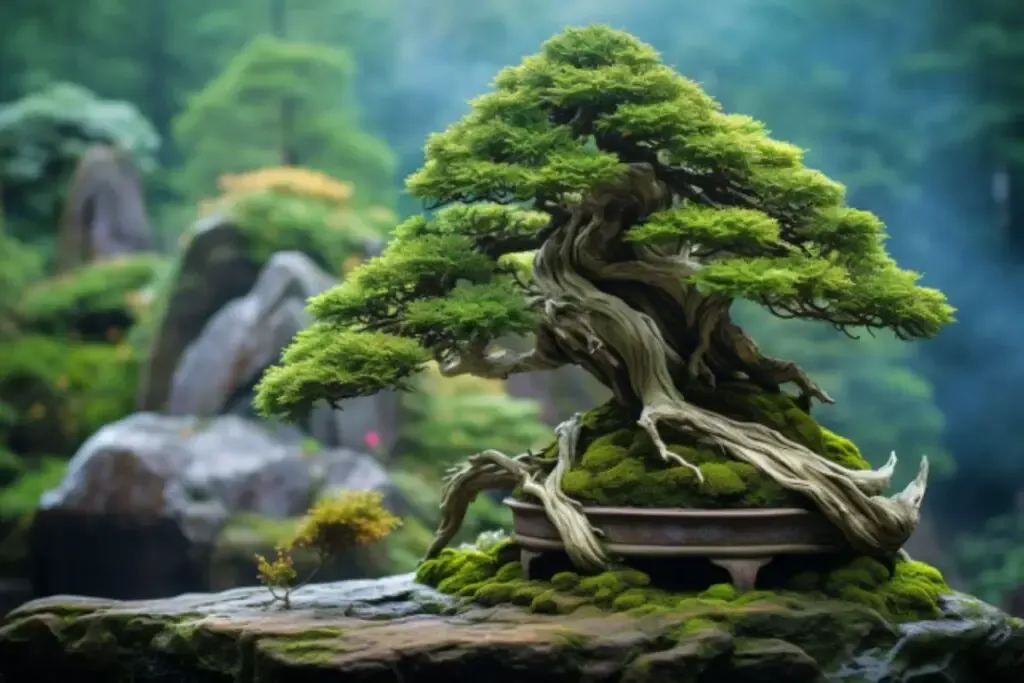
If you’re dipping your toes into the bonsai world, Junipers are your steadfast companions. Their resilience and dense foliage make them perfect for experimenting with various bonsai styles. It’s amazing how these hardy little trees can be shaped and molded, offering endless creativity for both novices and experts.
3. Ficus
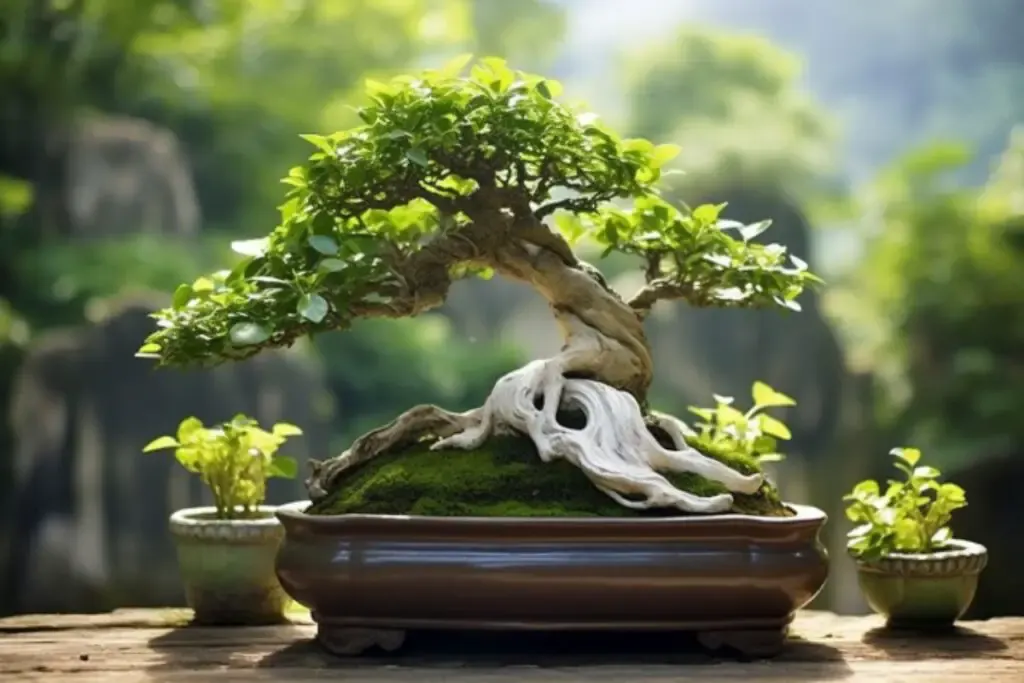
The Ficus is like the friendly, easy-going neighbor in the bonsai community. It’s incredibly forgiving, making it a top choice for beginners.
Thriving in indoor conditions and boasting intriguing root structures, Ficus bonsais are perfect for those looking to explore the captivating root-over-rock style. They’re a testament to the versatility and adaptability of bonsai trees.
Bonsai Tree Care
Caring for a bonsai tree is like embarking on a journey of discovery and patience, where every little detail matters. These miniature marvels require a unique blend of horticultural techniques and artistic vision.
Let’s explore the essentials of bonsai care!
Planting
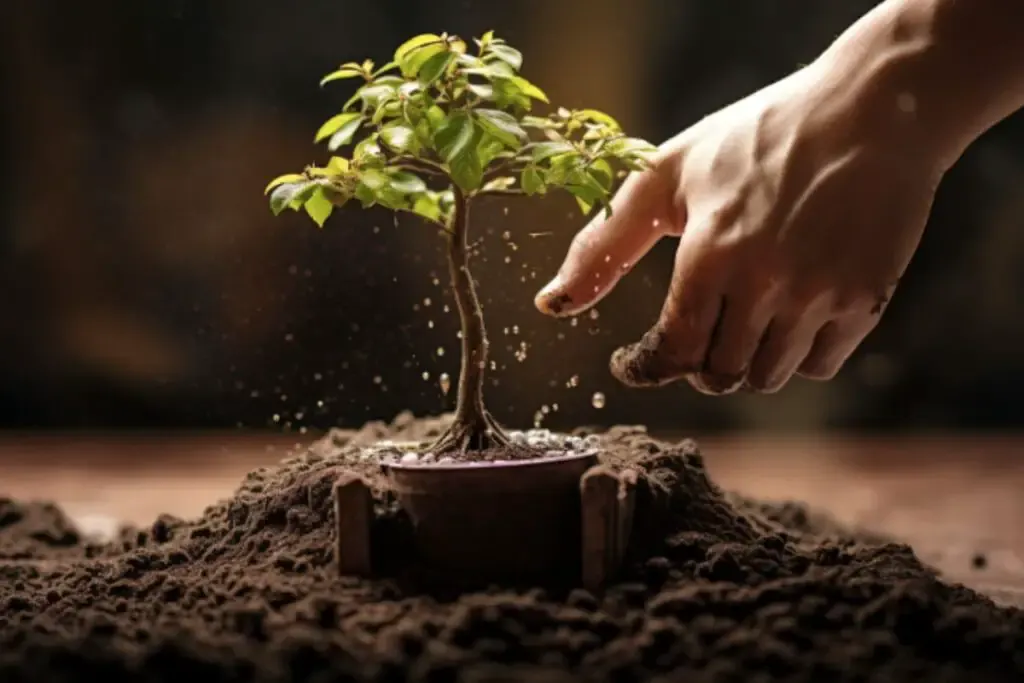
Planting a bonsai tree is the first step in a journey of growth and creativity. It’s where you set the foundation for your miniature masterpiece. Here’s how to start off on the right foot:
- Choosing the Right Container: Select a container that complements your bonsai’s size and style. Make sure it has adequate drainage holes to prevent waterlogging.
- Soil Matters: Use a specialized bonsai soil mix that ensures proper drainage and aeration. This soil will support your bonsai’s unique needs, providing the perfect balance for healthy growth.
- Positioning Your Tree: When placing your bonsai in the pot, consider its best angle and position. This is where your artistic eye comes into play. Think about how the tree will look from different viewpoints.
- Securing the Tree: Once you’ve found the perfect position, gently secure your bonsai in place. You can use special bonsai wire or ties to ensure it stays upright and stable.
Light
Just like finding the perfect spot of sunshine for a leisurely read, providing the right light for your bonsai is essential. These miniature wonders adore bright, indirect sunlight, basking in the gentle warmth without the harshness of direct rays.
Think of it as giving your bonsai a spot by a sunny window, where it can soak in the light while staying comfortably cool.
Soil
Choosing the right soil for your bonsai is like picking out a luxurious bed for a tiny king. The ideal mix should drain well yet retain enough moisture to keep the roots happy and hydrated. It’s a delicate balance, akin to creating a nurturing, fluffy cloud where your bonsai can rest its roots and thrive.
Water
Watering your bonsai is a gentle art, much like brewing the perfect cup of tea. It requires attention and care, ensuring the soil stays moist but not waterlogged. Imagine each watering session as a tranquil moment of connection, nurturing your bonsai with life-giving sips, not overwhelming gulps.
Temperature and Humidity
Watering your bonsai is a gentle art, much like brewing the perfect cup of tea. It requires attention and care, ensuring the soil stays moist but not waterlogged. Imagine each watering session as a tranquil moment of connection, nurturing your bonsai with life-giving sips, not overwhelming gulps.
Fertilizer
Feeding your bonsai is like providing a gourmet meal for a tiny, leafy gourmet. A balanced, gentle fertilizer nourishes your bonsai, encouraging robust growth and vibrant foliage.
It’s about giving your miniature tree just the right amount of nutrients, not too little, not too much, but just enough to help it thrive in its petite world.
Pruning
Pruning your bonsai tree is like conducting a symphony; each cut shapes the harmony of its miniature landscape. Here’s how to masterfully orchestrate this process:
- Striking the Right Chord: Think of pruning as a balancing act. It’s about enhancing the tree’s natural beauty while maintaining its health and proportions. Every snip is a thoughtful decision in crafting your bonsai’s story.
- Tuning with the Seasons: Timing is key. Engage in heavier pruning during the dormant season to shape and style, while lighter trims in the growing season help maintain its elegance.
- The Artist’s Tools: Arm yourself with sharp, clean bonsai scissors or shears. Precise cuts not only look better but also help your bonsai heal faster and stay healthy.
Propagating
Propagating a bonsai tree is like discovering a secret garden of endless possibilities. It’s a journey of creating new life from an existing one, a truly rewarding experience for any bonsai enthusiast. Let’s dive into the magical process of bonsai propagation:
- Layering Magic: Air layering is a popular method for bonsai propagation. It involves creating a new root system on a branch while it’s still attached to the parent tree. It’s like giving the branch its own identity before it ventures out on its own.
- Cuttings with Character: Taking cuttings is like cloning your favorite bonsai. Choose a healthy branch, snip it off, and plant it in suitable soil. With patience and care, these little cuttings will grow roots and become new bonsai trees, each with its own story to tell.
- Seeds of Potential: Starting a bonsai from seed is a slow yet immensely fulfilling process. It’s like nurturing a child, watching it grow from infancy to maturity, shaping its journey every step of the way.
How to Grow a Bonsai Tree From Seed
Growing a bonsai tree from seeds is like embarking on a long, enchanting journey, filled with anticipation and growth. Here’s how to start this magical adventure:
- Seed Selection and Germination: Begin by choosing your seeds, envisioning the future bonsai they will become. Treat them to a period of stratification if needed, then sow them in well-draining soil, providing a warm and bright environment for germination.
- Tending to Seedlings: Once sprouted, your seedlings are like tiny infants in need of gentle care. Ensure they receive adequate indirect sunlight and maintain a consistent moisture level in the soil, nurturing their delicate growth.
- Shaping Your Bonsai: As your seedlings grow, embark on the art of bonsai shaping. This involves thoughtful pruning and wiring, gently guiding each seedling into a beautiful and unique bonsai, reflecting your care and artistic vision.
Growing in Pots
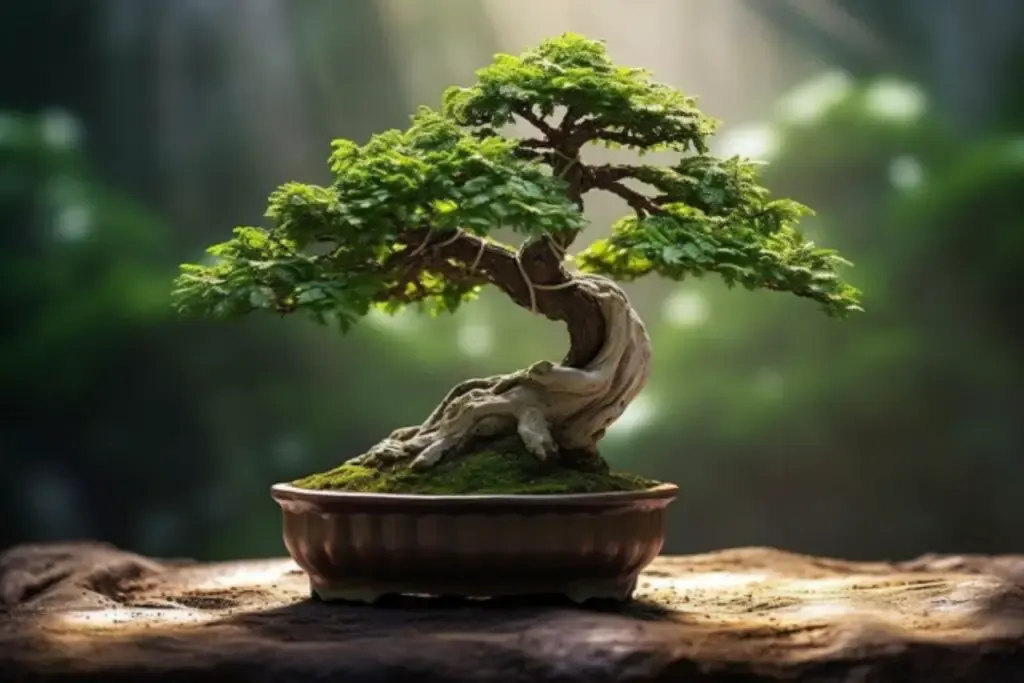
Growing a bonsai tree in a pot is like creating a personal haven of tranquility and beauty. Here’s how to cultivate this miniature natural masterpiece:
- Choosing the Ideal Pot: Select a pot that complements your bonsai’s style, making sure it has drainage holes to emulate its natural habitat and keep it thriving.
- Perfect Potting: Plant your bonsai in a specialized soil mix, considering its positioning in the pot for the best aesthetic and health, much like setting the stage for a tiny star.
- Ongoing Care in the Pot: Regularly water and fertilize your potted bonsai, and embrace the process of repotting every few years as a rejuvenating refresh, ensuring its continuous health and beauty.
Overwintering
As the seasons change, overwintering your bonsai tree becomes a cozy ritual to ensure its survival and flourishing come spring. Think of it as tucking your miniature tree into a snug winter bed. Here’s how to protect your bonsai during the colder months:
- Finding the Right Spot: Choose a sheltered location that protects your bonsai from harsh winds and extreme cold. It’s like finding a cozy nook for your tree to settle into.
- Monitoring Temperature: Keep an eye on the temperature, especially for outdoor bonsais. They need a cool period but should not be exposed to freezing conditions for prolonged periods.
- Watering Wisely: Reduce watering in winter, but ensure the soil doesn’t completely dry out. It’s a delicate balance, like giving just enough warmth without overheating.
Transplanting
Transplanting a bonsai tree is like giving it a new stage to flourish and showcase its beauty. It’s an essential step in the bonsai journey, ensuring the tree continues to grow healthily in its miniature world. Here’s how to transplant your bonsai with care:
- Choosing the Right Time: The ideal moment for transplanting is in the early spring, just as the bonsai starts to awaken from its winter dormancy. This timing gives your tree a whole growing season to adapt to its new home.
- Gentle Removal: Carefully lift your bonsai from its current pot, treating its roots with the utmost care. It’s a delicate process, akin to unearthing a treasure, ensuring the roots remain intact and undamaged.
- New Home Preparation: Select a new pot that complements your bonsai’s size and style, and fill it with fresh bonsai soil. Plant your bonsai at the same depth it was previously, like settling it into a comfortable, new abode.
Commons Pests and Diseases
In the intricate world of bonsai, keeping an eye out for pests and diseases is key to maintaining the health and beauty of these miniature trees. It’s like being a guardian, protecting your tiny forest from unwanted intruders. Here are some common challenges your bonsai might face and how to lovingly care for them:
Pests
- Spider Mites: These tiny critters can be tricky to spot, but they leave telltale webbing and yellow spots on leaves. A gentle spray of water or mild insecticide can help safeguard your bonsai from these unwelcome guests.
- Aphids: These little sap-suckers can cause leaves to curl and weaken the tree. A strong water spray or an application of insecticidal soap usually shows them the door.
Diseases
- Root Rot: Overwatering can lead to this soggy situation, where roots start to decay. It’s about finding that watering sweet spot – enough to quench, but not drown, your bonsai’s roots.
- Powdery Mildew: This appears as a white, powdery coating on leaves. Good air circulation and a bit of fungicide can help keep this fungal foe at bay.
In the bonsai world, prevention is always better than cure. Regular check-ups, proper watering, and a keen eye can keep most of these issues from ever troubling your bonsai. It’s all part of the journey in nurturing these living art pieces.
